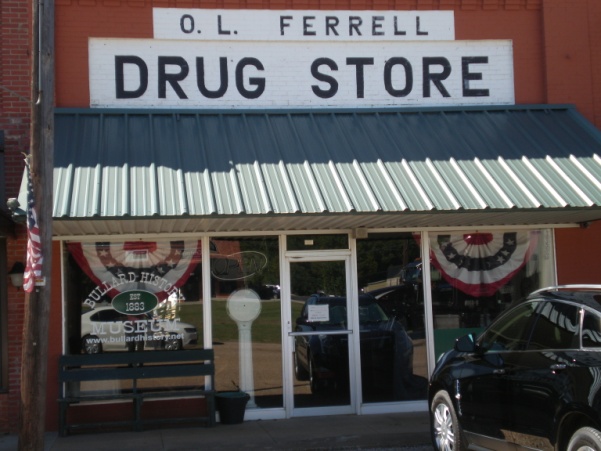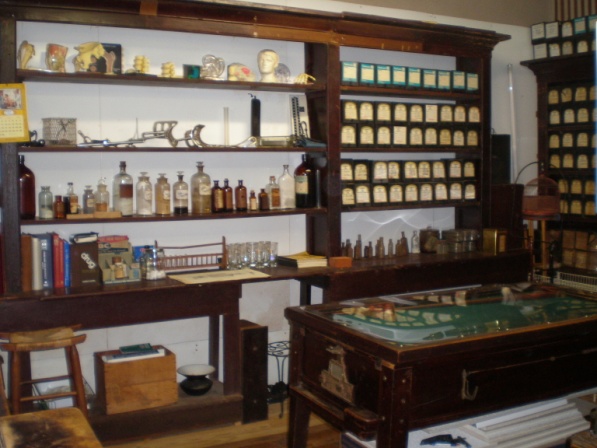.jpg) The Lady Doctor of Bullard, Texas
The Lady Doctor of Bullard, Texas
By Marvin Mayer
In December 2013, Marjorie Ferrell Roper Studdard voluntarily surrendered her license to practice medicine, ending a ground-breaking career that began 66 years earlier. Now enjoying "retirement," this delightful and charming lady can be found every Friday afternoon at her pride and joy, the Ferrell Drug Store Museum. One might say it was "back to the scene of the crime" as it was in this old drug store that she set up her practice back in 1947. But her connection to the Ferrell Drug Store dates back even farther.
Marjorie was born June 7, 1921, and although she didn't show signs of being drawn toward a career in medicine upon entering this world, to some it may have seemed so. When her baby brother was born just 15 months later, he became her constant companion and the object of her demonstrations of healing the myriad ailments rampant in her growing doll collection. Not so many years later, a 2nd grade teacher brought a paste to the classroom. As curious children are prone to do, many of her classmates ingested the sweet-tasting glue. Not surprisingly, several became ill. Marjorie's father, pharmacist Oran Luther Ferrell upon hearing of the incident, lectured the girls on the dangers of ingesting a material that had the potential to harden and create a blockage of the digestive system. That may have been the exact moment when Marjorie "began developing a curiosity regarding the concept of health vs. illness."
Bullard's town physician, Dr. Claude Rather, set up his practice in a small office in the back of the drugstore. How convenient this was for Marjorie. Literally living steps away from the back entrance to the drug store, she spent increasing amounts of time in the good doctor's office. Even though she was just a pre-teen, her attraction to the practice of medicine was not lost on Dr. Rather. While recovering from the effects of a stroke, he sometimes enlisted her help in tying and cutting sutures he had inserted into patients suffering minor lacerations. On occasion, she even accompanied him on house calls. Clearly, she was destined to become a doctor, but she was a female in a male-dominated profession.
Marjorie got her medical training at UTMB, the University of Texas' Medical Branch in Galveston. Her family wasn't initially supportive. She says she didn't even pack her bags for the trip to medical school until the night before she was to leave. Only then did the family realize how serious she was, and then they gave her their whole-hearted support.
Graduating in July, 1943 she completed medical school in just 3 years. Having proved her metal in medical school, she "landed a plum" when she interned at the prestigious Parkland Hospital in Dallas. Even there, her gender continued to be an obstacle as there were no living quarters for females. She "lived" through her internship sleeping in a patient room when not on duty. To combat the effects of boredom, she spent most of her off-duty waking hours hanging out in the emergency room, and even accompanied an associate on some of his ambulance runs.
In June of 1947, Marjorie set up her own medical practice at the place where she first felt the call to a medical career; the family Drug Store in Bullard. Although this was "home," the locals still thought of her as that precocious little girl who hung around the drug store. But there were forces at work that would help her change that image.
Bullard is situated in southern Smith County. The county line separating Smith from Cherokee literally runs through the town. It is surrounded by other small, country towns. The only doctors serving those towns had retired or were contemplating retirement. That left Marjorie as the only practicing physician servicing Frankston, Troup, Bullard, and Whitehouse. Still, "acceptance" of a woman doctor didn't come easily.
"Dr. Margie," as she affectionately came to be known, was the very essence of the stereotypical country doctor. She regularly made house calls. She sometimes stayed all night with her patients. It was not unusual for her to perform her services without being paid. She recalled one of her earliest house calls was to deliver a baby. The mother-to-be was only sixteen years old. The family lived in a low income area, but Dr. Margie didn't give the circumstances a second thought. As it turned out, she spent the entire night at the girl's home, catching short "cat naps" on the bed of the father-to-be. Throughout the long night, she remained at the house, eventually delivering a healthy baby boy. She laughs when she recalls the family never offered her a thing to eat, despite their preparing meals for themselves. She has outlived most, if not all, of that family, but she treasures a photograph of the entire family - children she helped deliver and people she called friends. The photo is prominently displayed at the Drug Store Museum.
The entire neighborhood where that first delivery took place has been replaced by Lake Tyler.
Ferrell's Drug Store closed its doors for good when a full service Brookshire's Grocery store was built. Dr. Margie continued her medical practice by working through several area clinics. Today, after overcoming all of those gender-related challenges, she is widely recognized as the outstanding doctor she has been. Even a street in Bullard is named for her!
This article wouldn't be complete without a "plug" for the museum. Located in the old family drug store at 105 Phillip Street, visitors are welcomed on Friday afternoons from 1:00 PM to 4:00 PM, or by appointment. It's more than a trip; it's a trip back in history.
Copies of Mr. Roper's book, Doctor Margie, Country Physician can be purchased while visiting the drug store museum, or through Amazon.com.


 Doctor
Doctor

